May 17, 2019
Air Date: May 17, 2019
FULL SHOW
SEGMENTS
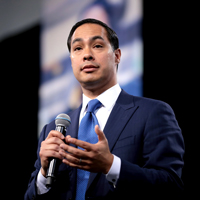
Julián Castro Campaigns
/ Steve CurwoodView the page for this story
Former Secretary of Housing and Urban Development and San Antonio Mayor Julián Castro is running for president as a Democrat, and climate change is one of the key issues he’s talking about on the campaign trail. At a recent meet and greet at a coffee shop and bookstore in southern New Hampshire, he laid out his climate agenda and why a green economy can be a strong, job-creating economy. Host Steve Curwood reports on how voters are responding to Secy. Castro’s green focus. (09:14)
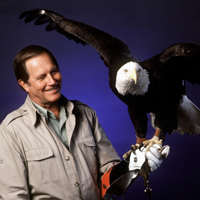
Remembering the Legacy of Jim Fowler
View the page for this story
Jim Fowler, Naturalist, conservationist, Tonight Show with Johnny Carson regular and and star of the Mutual of Omaha's Wild Kingdom, passed away May 8, 2019, at the age of 89. His years of bringing animals to American television helped educate viewers across the country about the importance of conservation. Host Steve Curwood recalls Jim’s influence on his own life, and reflects on his enduring legacy. (01:45)
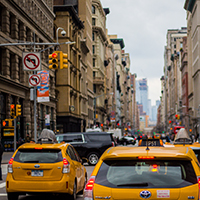
Congestion Fee for NYC
View the page for this story
New York City just became the first in the nation to adopt a congestion pricing plan. It’s expected to raise about a billion and a half dollars in revenue every year mostly for its crumbling subway system and cut down on some of Manhattan’s infamous traffic south of Central Park. Drivers who pay a $12 or so fee should also benefit from less congestion. Transport economist Charles Komanoff speaks with Host Steve Curwood about why he believes congestion pricing will make getting around New York City more efficient, reliable, and humane. (10:22)
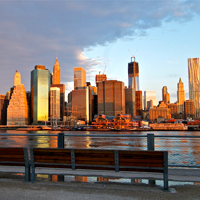
Cutting Emissions From NYC Skyscrapers
View the page for this story
New York City has taken a major step for climate protection by passing a series of laws that will reduce carbon emissions from the city. The centerpiece of the Climate Mobilization Act puts skyscrapers and other buildings of over 25,000 square feet on a low-carbon path, requiring them to cut emissions 40% by 2030 and 80% by 2050. John Mandyck is the CEO of the Urban Green Council, which helped develop the legislation, and joined Host Steve Curwood to discuss how these buildings can meet those benchmarks. (08:07)
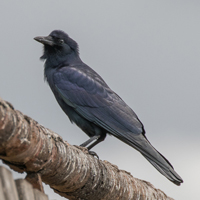
BirdNote®: Unlikely Places to Go Birding
/ Mary McCannView the page for this story
Traditional birding often lures birdwatchers deep into some wilderness, along the banks of a running river, or at the edge of an expansive meadow. But sometimes it’s the places we least expect that provide birders with that diamond in the rough. BirdNote®’s Mary McCann tells us more about the different and unlikely places that can be a birder’s goldmine. (02:05)
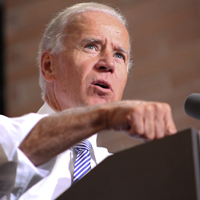
Beyond the Headlines
/ Peter DykstraView the page for this story
For this week's trip beyond the headlines, Peter Dykstra and Steve Curwood take a look at the recent statement by a Joe Biden aide that the Democratic presidential candidate would take a "middle ground" approach to climate change. Then, they discuss a United Nations agreement to eliminate plastic waste, but the United States is not in the deal. Finally, the pair reflects on the Lacey Act, a major conservation law signed by President McKinley in 1900 that prohibits illegal wildlife trade. (04:15)
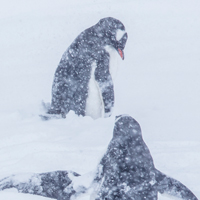
Leopard Seal Says Hello
/ Mark Seth LenderView the page for this story
During a frigid expedition through the Antarctic Ocean, Living on Earth’s Explorer-in-Residence Mark Seth Lender saw chinstrap penguins aplenty. Then, on his seventeenth and final day, he finally encountered the king of the South Pole: the mighty and fearsome leopard seal. (03:13)
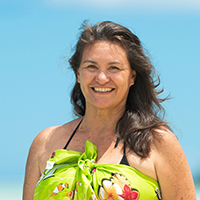
Protecting the Cook Islands from Overfishing
View the page for this story
99% of the tiny Cook Islands territory in the South Pacific is ocean, and home to coral reefs and many threatened marine species. Now, thanks to the Marae Moana, or “Sacred Ocean”, Act, the Cook Islands’ entire ocean territory is being managed for sustainability. Marine conservationist and Goldman Environmental Prize recipient Jacqueline Evans helped lead the campaign to protect her small island country’s waters, and joins Host Steve Curwood to talk about how she was able to get local communities on board. (06:22)
Show Credits and Funders
Show Transcript
HOST: Steve Curwood
GUESTS: Jacqueline Evans, Charles Komanoff, John Mandyck
REPORTERS: Peter Dykstra, Mark Seth Lender, Mary McCann
[THEME]
CURWOOD: From Public Radio International – this is Living On Earth.
[THEME]
CURWOOD: I’m Steve Curwood.
CURWOOD: Julián Castro of Texas is making his green case for the presidency.
CASTRO: There is no reason that China or any other country should beat the United States when it comes to actual jobs, as we embrace renewable energy, and we do the right thing. And I'm absolutely committed to making those investments and going towards zero on carbon emissions.
CURWOOD: Also, New York City is ramping up its efforts to address carbon emissions with congestion pricing and limits on large buildings.
MANDYCK: In essence it will deliver the largest carbon reduction in the history of New York and in the history of any city in the world. New York City has a mandate to reduce our carbon emissions 80 percent by 2050. Buildings represent 70 percent of those emissions. So, from a policy context the new law is a huge down payment.
CURWOOD: That and more this week on Living on Earth – stick around!
[NEWSBREAK MUSIC: Boards Of Canada “Zoetrope” from “In A Beautiful Place Out In The Country” (Warp Records 2000)]
Julián Castro Campaigns
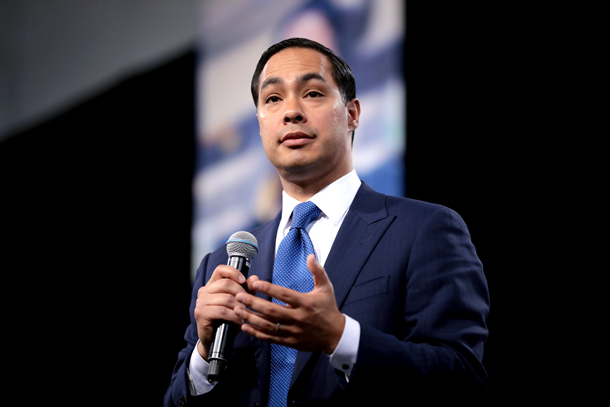
Julián Castro’s plans for his presidency include recommitting the United States to the Paris Climate Agreements and investing in renewable energy. (Photo: Gage Skidmore, Flickr, CC BY-SA 2.0)
[THEME]
CURWOOD: From PRI and the Jennifer and Ted Stanley Studios at the University of Massachusetts Boston, this is Living on Earth. I’m Steve Curwood.
In a season where the number of Democratic presidential wannabees is in the double digits, there is another double force emerging on the national political scene, the Castro brothers of San Antonio. Joaquin has been a member of Congress since 2013, but it’s his twin brother Julián who has the spotlight now. As mayor of San Antonio Julián was the youngest leader of an American city of more than a million before he was named, late in the Obama Administration, as Secretary of Housing and Urban Development. Now Julián Castro is looking to become the latest Texan and first Latinx and Hispanic president of the United States. In his search for votes in the New Hampshire primary he stopped by Crackskull’s Bookstore and Coffee House in Newmarket, New Hampshire, a homey and popular gathering place for progressives just down the road from the University of New Hampshire. But there were only one or two college students present among the two dozen or so mostly white and mostly older voters who greeted Julián Castro when he stepped through the door with a huge smile.
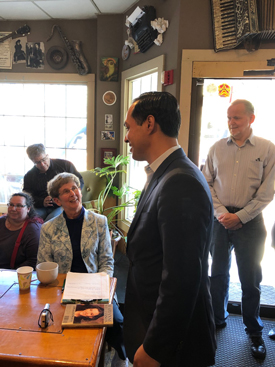
Julián Castro greets voters at Crackskull’s Bookstore and Coffee House in Newmarket, New Hampshire. (Photo: Steve Curwood)
[CHATTER AND APPLAUSE]
CASTRO: I'm not one for trying to make this country anything again. I don't want us to go backward. I want us to go forward. I want us to look to the future.
[APPLAUSE]
CASTRO: With the -- with one, with one exception: that I want to return integrity and decency to the Oval Office.
MAN: Right on! [APPLAUSE]
CASTRO: I got tested early on in my public service tenure. I went back home, I got a job at the biggest law firm after I graduated from law school. I went with my brother, by the way, I couldn't get rid of him.
[LAUGHTER]
CURWOOD: His brother Joaquin soon won a seat in the Texas legislature and Julián himself won a spot on the San Antonio City Council -- and an ethical challenge.
CASTRO: And a few months after I got elected the law firm got a client. The client had a deal that they wanted us on the city council to approve, because I was still working at the law firm.
The land deal was that they wanted to build a golf course over our water supply, because we rely on an aquifer for our water. And there were like one or two other golf courses that had been built years before in that area. But I had concerns that that environmental plan for this one was not nearly strong enough, and so that it might compromise the drinking water when they use all of the chemicals, the fertilizers, pesticides, everything else on a golf course, which has to be maintained in an intense way. So, I wanted to vote against this land deal, though, of the client of the firm, and my constituents want me to vote against it too. But under the professional rules of conduct for lawyers -- the lawyers in the room will appreciate this, probably like this in New Hampshire too -- you can't just go against the interests of a client.
And so, I was stuck. You know, my constituents, were saying, Hey, man, are you going to represent us here, you gonna vote against this? And, but my livelihood -- I had gotten, I had bought a house, I had bought a new car, my student loans were between $900 and $1,000 a month at that time -- my livelihood depended on me basically shutting up, and doing nothing. Just being conflicted out. So, one day in January of 2002, I walked into the law firm, and I quit my job. And then I went and I voted against that land deal on the city council.
[APPLAUSE]
And I tell you that because before I ever went into politics, I worried that I would somehow have to change who I was, in order to succeed. You know, you hear that politics can be dirty or corrupting, that you have to play this game with certain people that always seem to get their way.
CURWOOD: Every Democratic contender for president who comes to New Hampshire can count on getting asked about the environment, especially climate change, and a state representative from nearby Dover asked Secretary Castro to lay out his climate agenda.
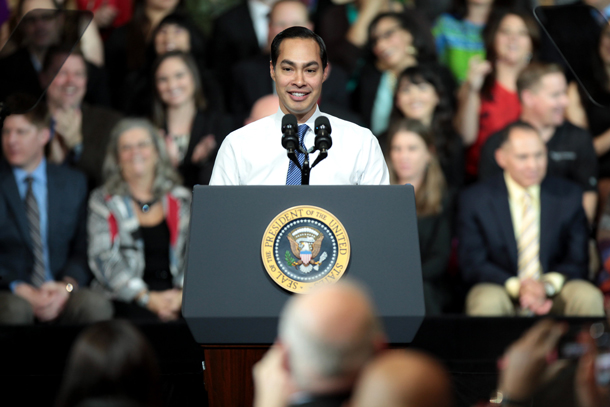
Julián Castro served as Secretary of Housing and Urban Development under the Obama Administration. (Photo: Gage Skidmore, Flickr, CC BY-SA 2.0)
CASTRO: My first executive order would be to recommit the United States to the Paris Climate Accord.
[APPLAUSE]
CASTRO: But it really is, you know, I mean, that's the easy part. You know, the harder part is, I believe that we need to invest in a big way in sustainability. And, you know, I like the concept of the Green New Deal, for instance, because I don't think that we have to choose between protecting our planet and creating jobs and opportunity. In Texas, for instance, we have seen the benefits of the new energy economy, the solar energy industry, the wind energy industry. And so, I believe that we can do both of those things. I also have a track record on this; when I was the mayor of San Antonio, I served on the board of the local public utility, CPS Energy. When I got onto the board, you know, about 40% of our power generation was coming from two nuclear reactors in South Texas. And what was on the table at that time was, was a stake in developing two more nuclear reactors. This was in 2009. This was before Fukushima, right. And we found out at the last minute, right before we approved the deal, that the local utility had not told us that the cost was actually going to be two to four billion dollars higher than we knew. And so, I withdrew our support from that, and make changes on the board. And instead, we started moving the utility to invest in renewable energy. We did a deal for a 400-megawatt solar facility. But we didn't stop there. We also said, Look, if we're going to make that investment, then we want the jobs that come along with it, right, because you can have a whole bunch of solar panels in a field somewhere. But really, that's, that in and of itself is not that many jobs, right? So, we actually got the company that we struck a deal with to bring the whole manufacturing chain of those solar panels to San Antonio. So, they created 800 jobs in that area. That's the model that I would like the United States to work off of, there is no reason that China or any other country should beat the United States when it comes to actual jobs, as we embrace renewable energy, and we do the right thing. And I'm absolutely committed to making those investments and going towards zero on carbon emissions.
CURWOOD: A young man working as a barista in the coffee shop challenged Secretary Castro to see if the candidate was just talking the talk about climate protection or is willing to walk the walk when it comes to financing his campaign.
BARISTA: I like your statement about fossil fuels and how we need to go towards a more sustainable environment and like, like contribute to the infrastructure and like support jobs in the field, too. And I think something else that's really important that a lot of candidates have also got on board on is not accepting any money from fossil fuel companies. And I was wondering if you could promise to do that?
CASTRO: Yeah. In fact, I don't, not sure if we have or have done that yet. But yeah, we've agreed, basically, we're already practicing that. And so, at some point, I'm going to formally sign that pledge. I think something like 11 or 12 of the candidates have, which I've been glad to see. So, we are, from the very beginning, we've known, you know, beginning of the campaign about that pledge and had been careful trying to sort out like if a contribution comes in that doesn't meet that not accepting that. So, we will yeah, absolutely.
CURWOOD: And for the record, Julián Castro has said he will not accept any money from political action committees — PACs — contribution bundles that often promote special interests. As the candidate headed out for an appearance at another popular coffee hangout in nearby Dover, a couple of older gentlemen still sitting at a table gave me their impressions of Secretary Castro’s environmental platform.
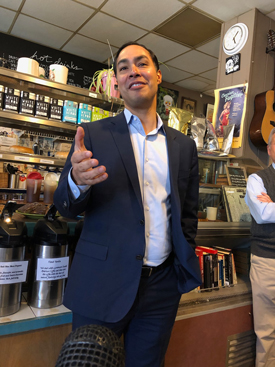
Julián Castro speaks with voters at Crackskull’s Bookstore and Coffee House in Newmarket, New Hampshire. (Photo: Steve Curwood)
MAN: I thought he gave a very good answer. He, he's for for re-instituting our involvement in the Paris Accords and so forth. So, I think he's got good answers. I think his answers are well thought out. And, and intelligent answers. I like the things he had to say today.
CURWOOD: What's your top priority as an environmental voter?
MAN: Well, we are by all accounts facing, you know, a disastrous near-term future. If we don't, we don't get our act together, we're going to be past the point of no return. So, we've got to do something now, we have to have somebody who wants to acknowledge where we are, and we have to do. And the President is going in exactly the wrong direction.
CURWOOD: It’s still early in the Democratic presidential contest, and these New Hampshire voters seemed to like Julián Castro’s fresh face and his folksy rather than fiery style that speaks of integrity, and his brown, black and white campaign that reflects the diversity of today’s American electorate. So far Julián Castro has yet to raise as much money as some of the other contenders, but he does have enough donors and early polling results to qualify for the first televised debates in June, and that means he still has a chance for his campaign to catch on. And by the way, just to avoid confusion, his identical twin brother has grown a beard.
Related links:
- Julian Castro’s 2020 Presidential Campaign Website
- NewStatesmanAmerica | “Julian Castro Interview: “I have the experience and I can win against Donald Trump””
[MUSIC: Louis Armstrong & Duke Ellington, “Duke’s Place” on Louis Armstrong & Duke Ellington: The Complete Sessions, by Roberts-Katz-Thiele-Ellington, Capitol Records]
Remembering the Legacy of Jim Fowler
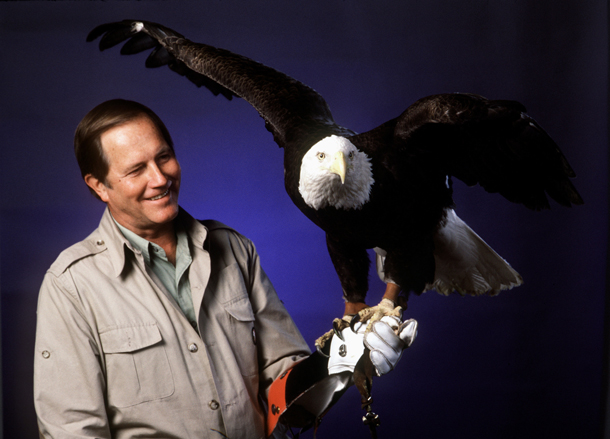
Jim Fowler of Mutual of Omaha's "Wild Kingdom" television program admires a bald eagle at the U.S. Air Force Association's annual gathering, during which the 40th anniversary of the Air Force is being celebrated. (Photo: United States National Archive, public domain)
CURWOOD: Earlier this month we heard the sad news of the passing at age 89 of Jim Fowler. Now if you’re old enough you might remember Mutual of Omaha’s Wild Kingdom, with Marlin Perkins and Jim. These days of course there are wild animal programs on cable TV 24-7, but back in the 1960’s and 70’s, with only three national networks, wild animal programming was as rare as some of the animals Jim and Marlin presented. They had fun debunking myths like Groundhog Day and snake charming, and they took expeditions to show viewers the gentle side of gorillas, the desert-savvy leopards of the Kalahari and the prehistoric-looking Komodo dragons. And they helped people understand why we needed an Endangered Species Act. Marlin Perkins died more than 30 years ago, but Jim Fowler kept keeping on, not just on Wild Kingdom but also on Animal Planet in his later years. And Jim was probably most famous for his dozens of appearances on the Today Show and Merv Griffin, as well as the Tonight Show with Johnny Carson and Late Night with Conan O’Brien. And without being disrespectful to the animals he brought on the set, he rolled with the comedy of those shows.
By the way, I looked up to Jim Fowler, not just because he was six feet six but also because he was an alum of my high school -- Westtown School outside Philadelphia -- and many times brought critters like snakes, owls and foxes to school assemblies. I could also see him up close when he would visit his brother and my mentor, Westtown teacher and playwright Earl Fowler.
What I remember best about Jim Fowler, aside from some belly laughs while watching him and his creatures on TV and stage, was his constant reminder that we need to take care of all of nature, because it takes care of all of us.
Related links:
- More about Jim Fowler and his time with Wild Kingdom
- The New York Times | “Jim Fowler, Naturalist and a Face of TV’s ‘Wild Kingdom,’ Dies at 89”
[MUSIC: Paul Winter, “Bedrock Cathedral” on Canyon: A Celebration Of the Grand Canyon, by John Clark, Living Music Records]
CURWOOD: Coming up – The Big Apple is getting greener. That’s just ahead on Living on Earth.
ANNOUNCER: Support for Living on Earth comes from Sailors for the Sea and Oceana. Helping boaters race clean, sail green and protect the seas they love. More information at sailorsforthesea.org.
[CUTAWAY MUSIC: Louis Armstrong & Duke Ellington, “It Don’t Mean a Thing” on Louis Armstrong & Duke Ellington: The Complete Sessions, by Mills-Ellington, Capitol Records]
Congestion Fee for NYC
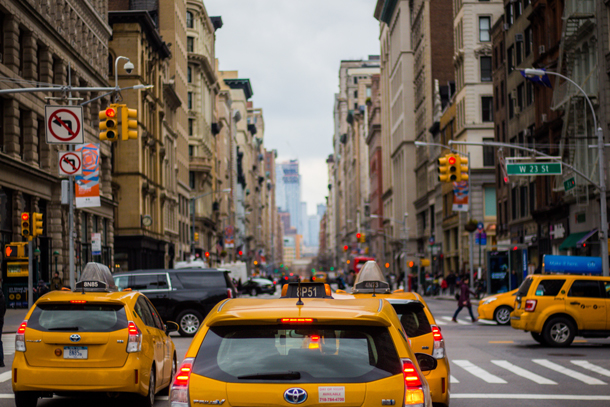
New York City’s congestion pricing plan aims to reduce the number of cars on Manhattan’s streets by just 15%, which should improve travel speeds. (Photo: Ferdinand Stöhr on Unsplash)
CURWOOD: It’s Living on Earth, I’m Steve Curwood.
[TRAFFIC SOUNDS]
CURWOOD: Anyone who’s been to New York City knows that Manhattan is almost a continual traffic jam certain times of day and its aging subway system needs help. But getting around the city will soon be a little easier, thanks to a new congestion pricing scheme that will charge fees if people bring vehicles to Midtown and Lower Manhattan, and use that money to fund public transit. London, Stockholm and Singapore have already adopted such plans, though New York would be the first in the US. And in 2021 it would begin charging private passenger cars an estimated $12 or more during peak business hours, though the exact fee has yet to be set. Transport economist and environmental activist Charles Komanoff directs the Carbon Tax Center and has advocated for congestion pricing in New York City for years.
KOMANOFF: It's a real pushing back against the automobile, which is sorely needed in my hometown of New York City and in other major cities throughout the country, and really around the world, where the automobile has been permitted to dominate, not just travel and transportation, but streets and public space and the very life of great cities. And the other is that the advent of congestion pricing for New York City is going to represent the first time that anywhere in America is going to tax or charge or put a considerable price on an environmental harm. And here, the environmental harm that's going to be charged with congestion pricing is not tailpipe emissions, it's not carbon emissions. It is the physical presence of the car itself that contributes to traffic congestion, that slows down other drivers as well as buses and pedestrians and bicyclists, etc. But the idea of taxing or charging an environmental harm has been a really tough sell in the United States, especially with carbon emissions. And now New York City is going to blaze a path and do that for congestion. And so maybe that will spill over sometime down the road for carbon pricing.
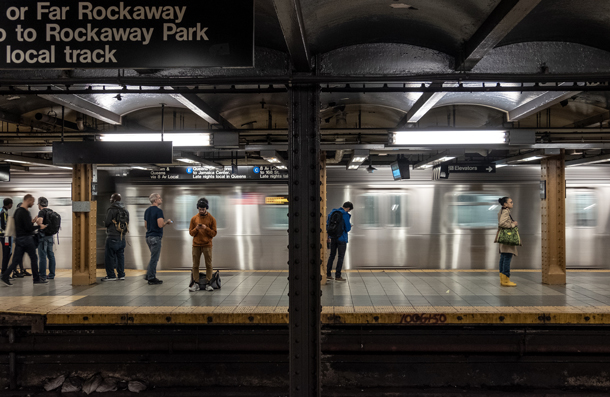
The major share of the approximately $1.5 billion in yearly revenue from the congestion pricing plan is expected to go a long way towards modernizing New York City’s aging subways. (Photo: Pat Krupa on Unsplash)
CURWOOD: So talk to me about the money involved here. What are your projections as to how much money will come into the coffers of New York City as a function of this congestion pricing?
KOMANOFF: Well, about a billion and a half dollars a year. And I want to split that between about a billion that's going to come from the car and truck trips that are going to be charged when they cross into the heart of Manhattan, the Manhattan central business district; and another half a billion, roughly, from charging yellows and Ubers and Lyfts — only for trips that ply the same district, actually it extends a little bit further north, the taxi charging zone is up to 96th Street. And so that combination of money, a billion and a half dollars in revenue a year, is going to be enough to bond 20 to 25 billion dollars in mass transit investment, most of which is going to be allocated -- or should be, and I hope, will be — to modernizing the signal system in the subways so that we can run more trains per hour on the existing subway lines, cut down on hellish subway crowding, cut down on the unreliability of subways, and return them to the level of service that they had up until about eight or 10 years ago when the service reliability on the subways began to crater.
CURWOOD: So I imagine somebody living, say, in New Jersey, is looking at this and saying, "Oh, no." And what do you say to them?
KOMANOFF: Well, Steve, funny you should mention New Jersey, because the Lincoln and Holland tunnels that go from New Jersey under the Hudson River, into these southern and central parts of Manhattan are unlikely to be charged additionally under this new congestion pricing plan, because they already pay a hefty toll. But if you drive east on the George Washington Bridge, which, as you know, comes into northern Manhattan, well, you'll continue to pay that toll. But if you then continue south and cross 60th Street in Manhattan, then your trip is going to be charged the same as any other trip crossing 60th Street, whether it's coming from Scarsdale, or Yonkers, or the Bronx or New England or Canada; and ditto, by the way, for trips coming from geographic Long Island, from Queens and Brooklyn that are going to be crossing into Manhattan on any of the four East River bridges that are now free. And what we say to people who are going to be forking over an additional $12 or so to drive into the Manhattan central business district, because that's probably about what the toll is going to be set at, is, Yeah, that's a hefty charge. But you will get several things from it, even you the driver. You're going to get a faster commute, because there will be somewhat fewer other drivers on the road. The idea is to set the congestion charge at a level that will dissuade about 15% of the trips from taking place. And the travel speed improvements from just getting rid of 15% of the trips are more than proportional. You will also be getting better transit alternatives so that if you want to take a train or a bus, those alternatives are going to be more reliable and more frequent and more comfortable and faster. And finally, there will be even fewer trips kind of down the road as the congestion revenues get invested in better mass transit, because even if you're committed to your car 365 days a year, not everybody else on the road is going to be committed, and some people are going to hop off the roads and get onto those transit alternatives. So, I'm not going to say that everybody is going to come out ahead of the game, but some drivers will. And the vast majority of trips into the central business district that are done by train and bus, they're going to be more humane, more efficient, more reliable, and more people are going to want to do them.
CURWOOD: Talk to me about how many commuter hours per day your spreadsheet indicates that people will be able to save.
KOMANOFF: Well, about half a million hours per day. Now that's a kind of abstract number, maybe more to the point is that when you total up all of the benefits of a robust congestion pricing plan, which include mostly the time savings, but also, more people are going to bike and walk which means they'll be healthier, the air will be cleaner, people will live longer, fewer visits to the ER for asthma and heart attacks, fewer people being killed and injured by cars, you know, less carbon being spewed into the air -- on and on, the net benefits even after you deduct the new tolls, which people are going to be paying, come out to about three and a half to four billion dollars a year. So another way of putting it, is that every day we don't have congestion pricing, we are leaving on the table 10 million dollars' worth of benefits -- mostly time savings for New York City commuters and travelers and residents. And I can't wait till January 1, 2021, when the system starts and we begin to reap those huge benefits.
CURWOOD: Now, what about the idea of giving, say electric vehicles a break, or handicapped people a break?
KOMANOFF: Well, those are two really different questions. People with disabilities should get some sort of exemption; the legislation requires that this six-person panel come up with a way to discount their tolls. And you know, maybe it shouldn't be a total exemption, maybe it should be reduced down to the cost of a subway fare. But of course, there needs to be accommodations for people with genuine disabilities. But electric vehicles: uh-uh. We need to hold the line and have EVs pay the same congestion charge. Because the main harm, or social externality cost, of driving in the crowded, teeming heart of New York City isn't what comes or doesn't come out of the tailpipe. It's the physical presence of that vehicle that slows everybody else down. And this is a congestion plan; it's not really an environmental plan. And we can talk about the larger environmental benefits of congestion pricing. But it's not so much because of tailpipes being cleaned up or removed. It's because cities, starting with New York, are going to be able to work better, and we need cities to drive the Green New Deal, the climate transition to a sustainable U.S. and sustainable planet.
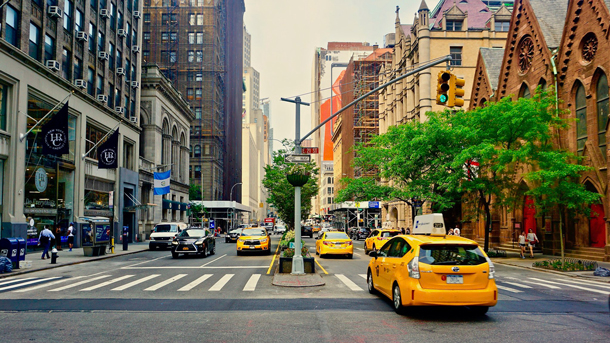
Charles Komanoff says congestion pricing will make everyone’s commute “more humane, more efficient, and more reliable.” (Photo: Andreas Komodromos, Flickr CC BY-NC 2.0)
CURWOOD: You know, Charlie, you look back in history, and — cities were invented before automobiles. What does that mean, in terms of the response now to, hey, let's start to limit them with something like congestion pricing?
KOMANOFF: Yeah, exactly. Steve, you know, in the 20th century, we had 50 years of accommodating the automobile and nothing else, because the automobile allows no countervailing force. And then we had another 50 years, you know, from the 1950s, into the early part of this century, where people tried to rise up against that, and all that they were able to do was to slow the continued takeover of the city by the automobile and maybe begin to put in a few beachheads of opposition, like bike lanes here and there. Congestion pricing really does begin to level the playing field. It not only charges drivers for the congestion that they impose on everybody else and on each other, but it signals, I think, a new era, where cars don't come first. They are part of a transportation ecosystem, they are not the only part of it. And they have to be consigned to something that doesn't dominate. And that's going to open the door to different ways of living in New York and other great cities that we can only dream about now.
CURWOOD: Charles Komanoff is a transport economist and environmental activist who directs the Carbon Tax Center in New York City. Thanks so much for taking the time with us today.
KOMANOFF: Steve, thank you very much.
Related links:
- Watch: “How to Move More Cars, Faster” – Congestion Pricing Explained
- Charles Komanoff’s Balanced Transportation Analyzer
- The New York Times | “Confused About Congestion Pricing? Here’s What We Know”
- NPR | “City Dwellers Don’t Like The Idea Of Congestion Pricing – But They Get Over It”
[MUSIC: 2008 Capitol Records. Album LOVE, Beatles — Drive My Ca͏r, The Word, Taxman]
Cutting Emissions From NYC Skyscrapers
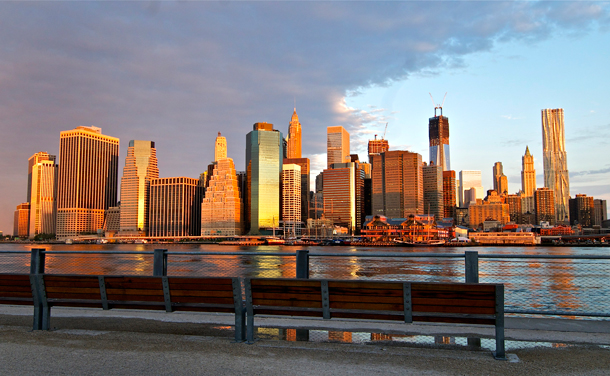
70% of New York City’s climate changing emissions come from powering its million or so buildings. (Photo: Göran Johansson, Flickr, CC BY-NC 2.0)
CURWOOD: Congestion pricing will likely reduce greenhouse gas emission in New York City, but the biggest emitters are buildings, and a new ordinance requires large buildings to cut their emissions by 40% in 2030 and 80% in 2050. John Mandyck is CEO of the Urban Green Council, which promoted this ground-breaking legislation, and he joins us now. John, welcome to Living on Earth!
MANDYCK: Hi, Steve.
CURWOOD: Briefly summarize for me the Climate Mobilization Act.
MANDYCK: Well, the main center point of the Climate Mobilization Act is a showcase bill that will reduce carbon emissions in large buildings in New York City 40% over a 2005 baseline. So, there's some progress that's already been made. In reality, what has to happen over the next 11 years is a 26% reduction, which is very, very significant in itself. In essence, it will deliver the largest carbon reduction in the history of New York and in the history of any city in the world, given the scale of buildings that we're dealing with in New York City.
CURWOOD: Under this law, how are buildings expected to meet this target?
MANDYCK: Well, the law sets a really tough cap on building emissions, and they do it through 10 different building types. So if you fall into one of those 10 building types, you have a specific cap that you have to meet. So building owners really have six ways that they can meet the new requirements, they can lower carbon emissions. They can switch their fuels, so if they're using oil, they could switch to natural gas or something else. They could buy renewable power, which is an offset that's allowed in this bill. They can buy an additional offset yet to be defined. They could potentially trade carbon, which is a big part of the bill and the new law, that Urban Green worked to have included, it's a new study on how we could trade carbon in New York. And the sixth item is they could just pay the fine, but the fines are enormous, they're $268 per ton over the cap. So if you're far over the cap, you could face fines in the millions and millions of dollars.
CURWOOD: So, tell me how does the carbon trading aspect of this bill work?
MANDYCK: Well, what the law requires is that the city conduct a study and implementation plan for how carbon trading could work in New York City. And they have to do that by 2021. So this is an accelerated timetable. And we're really excited about this particular aspect of the new law, we worked very hard to have it included, for several reasons. First, carbon trading will make meeting the really tough caps in this law more feasible. And in essence, if you're a large portfolio owner in New York City, of which there are many, you blend your average to meet the new law, because you trade between yourself. So that's an important mechanism. Secondly, carbon trading, if done right, I believe, can provide a new source of capital for low-to-moderate income neighborhoods in New York City, which in some cases have missed out completely on the sustainability movement. And the way that can happen is, carbon reductions in those neighborhoods could be given extra credit. So, if you provide a carbon reduction in a low-to-moderate income neighborhood, you could get two-to-one, three-to-one, five-to-one credit to trade to commercial owners in Manhattan. We think that will create new business models and provide new sources of capital to bring carbon reductions in those neighborhoods.
CURWOOD: What's been the pushback on this?
MANDYCK: The pushback is cost. This will cost billions and billions of dollars for real estate owners. And I understand that, I get it, we worked hard to make sure that the bill can be implemented in a more feasible way. Carbon trading is one way that that can happen. But make no mistake, in my estimation, this will be the largest disruption in the history of New York City real estate. 50,000 buildings are going to have to do something, billions of dollars are going to be spent, new technologies will be needed. Labor will have to be staged, retrofits will have to be done in a whole new way. And so with disruption comes risk and opportunity. And so I think what people are starting to look at is exactly that. What are the risks that can be mitigated? What are the opportunities that can be pursued to understand, now that the game field has changed, how are we going to meet the requirements that are being set out?
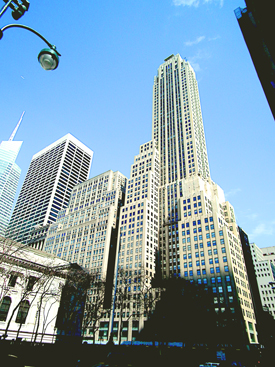
A third of NYC’s building emissions come from buildings of 25,000 square feet or more, of which there are only 50,000. (Photo: Sam Topping, Flickr, CC BY 2.0)
CURWOOD: John, with that list of challenges, how the heck were you able to get this through?
MANDYCK: Well, you have to understand the broader context here. And it really breaks down in three points. There's a policy context, New York City has a mandate to reduce our carbon emissions 80% by 2050. It's a big goal. Buildings represents 70% of those emissions. So, from a policy context, the new law is a huge down payment in how we get to the "80 by 50" goals. And the economic context is the fact that New York State has $3 trillion of insured coastal assets, that's twice the GDP of Canada. We have a lot at risk when it comes to climate change. And Superstorm Sandy is no better example than that. It left a $20 billion bill. So, we have to be prepared from a climate standpoint, to protect the assets of the city. And then, the third context is the environment. We see the effects of climate change every day. It's no longer theory. It's here. It's real. New York Harbor is up one foot in the last century. And so when you look at the policy, economic, and environmental context, you can see why it pushed policymakers to take action.
CURWOOD: How important is it that New York City is doing this? Some would say New York is the capital of the world, at least has the UN in it, anyway.
MANDYCK: It's really important because it shows cities can act on climate change. And in fact, cities have policy levers that often national governments don't have. So if you look in the case of buildings, in the United States, the federal government has no regulatory purview over buildings. And so to look at the number one source of emissions in a big city, it's really the city that has to act.
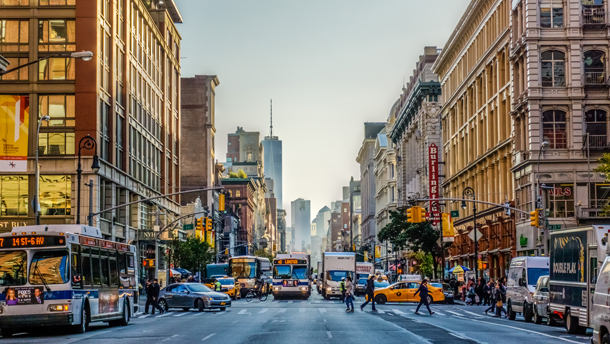
New York City has committed to reduce their emissions at least 80 percent by 2050, and the Climate Mobilization Act provides six pathways for the city’s buildings to achieve this goal. (Photo: Jeff Turner, Flickr, CC BY 2.0)
CURWOOD: John Mandyck, in any given city, why do buildings matter so much?
MANDYCK: Buildings matter a lot to climate change. If you look across the world, buildings consume about 30% of global energy. But if you look in a city like New York, buildings consume 70% of the energy in New York. And that's not atypical for large urban centers. It's about the same proportion in London, for example. And that's because we have different profiles in large urban centers, and some other cities, in the sense that we have strong and carbon-efficient public transportation systems. They may not always run on time. But they move a lot of people and they do it in a carbon efficient way. So the carbon profile of New York for buildings is quite different than LA, where cars play a much bigger role. In New York, because cars are not on the road, and transportation is efficient, what's left are buildings. And so buildings play a big role in carbon emissions. And they're the source of how we can achieve a lower carbon future.
CURWOOD: Now, the Urban Green Council helped to create this legislation. What other plans do you have for similar legislation ahead?
MANDYCK: Well, we think there's great opportunity in the carbon trading idea. And so we're going to be pursuing how that can work in New York, and how that could work around the world. This is one policy that's exportable. Carbon trading can work anywhere in the world. And that's important because we're going to spend billions and billions of dollars in New York City to meet this new law. And when we do so, if other cities don't act, New York Harbor is still going to flood, because climate change is a global problem. So we have to do our part in New York, and we have to show leadership for how cities can reduce carbon emissions at a historical level. But we have to do it in a way, providing ideas for other cities to look at. Carbon trading is one of those.
CURWOOD: John Mandyck is the CEO of the Urban Green Council in New York City. John, thanks so much for taking the time with me today.
MANDYCK: Steve, it was great to spend time with you. Thank you.
CURWOOD: And by the way, there are eight buildings that carry the name of President Trump in Manhattan. And if those don’t reduce or offset their emissions by 2030, they will be liable for more than two million dollars a year in fines.
Related links:
- Urban Green Council | “All About NYC’s Historic Building Emissions Law”
- Urban Green Council
- The New York Times | “Big Buildings Hurt the Climate. New York City Hopes to Change That.”
- Wired | “New York’s Aggressive Climate Law Takes Aim at Skyscrapers”
BirdNote®: Unlikely Places to Go Birding
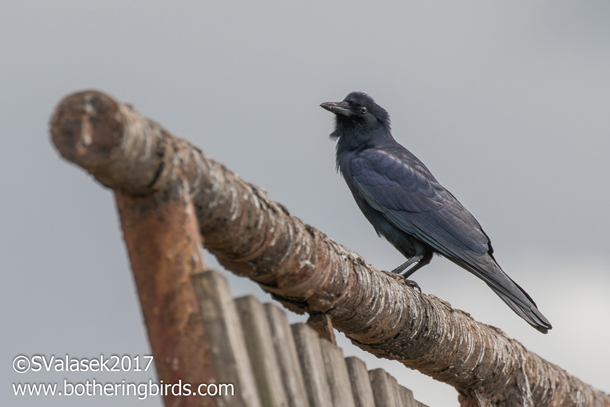
The Tamaulipas Crow is a species that is endemic to Mexico. But you can spot them in the southernmost corner of Southeast Texas, as well. (Photo: Steve Valasek)
[BIRDNOTE® THEME]
CURWOOD: Central Park in New York City is a hotspot for birders thanks to its patch of green amid a concrete jungle, and some 280 species of birds have been spotted in the park since it was completed in 1876. And as BirdNote®’s Mary McCann reports there are plenty of other surprising places to find a wide variety of birds.
BirdNote®: “Unlikely Places to Go Birding”
MCCANN: Location! Location! Location!
Location is just as important in birding as in real estate.
But unlike real estate, where the prime location has a panoramic view or great ambience, birding is often best in the most unlikely places.
For instance, sewage treatment plants are great places to look for birds. Watch for gulls, ducks, and the ever-vigilant raptors keeping watch, nearby.
[Cries of Glaucous-winged Gulls]
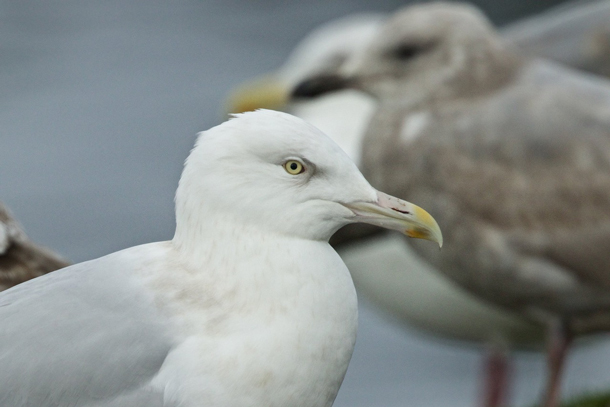
The Glaucous-winged Gull has been known to hybridize with the Western Gull. (Photo: Gregg Thompson)
Another place might be your local landfill or dump.
[Garbage truck sounds]
From Alaska to southern Texas, dumps are often great places to find good birds. The Juneau, Alaska landfill is famous for its “gathering of gulls,” and you used to be able to find lots of ravens, too.
[Gronk-gronk of Common Raven]
And at the southern tip of the country, the Brownsville, Texas dump was, for years, the only place in the US you could find a Tamaulipas Crow.
[Caws of Tamaulipas/Mexican Crows]
For a more sedate birding adventure, visit a cemetery.
[Soft twittering of a House Finch]
Especially in rural areas and in the Midwest, cemeteries are often repositories of native plants, remnants of the native habitats of the 19th century. They’re magnets for migratory birds, which find food—and cover—in those green oases. They’re quiet, too.
Just remember: birds are where you find ‘em.
[Soft twittering of a House Finch]
###
Written by Ellen Blackstone
Bird audio provided by The Macaulay Library at the Cornell Lab of Ornithology, Ithaca, New York. Glaucous-winged Gulls recorded by A.A. Allen. Common Raven calls recorded by R.S. Little. Tamaulipas Crow recorded by L. Irby Davis. Song of the House Finch recorded by G.A. Keller.
Producer: John Kessler
Executive Producer: Chris Peterson
© 2014 Tune In to Nature.org
April 2017/2019
Narrator: Mary McCann
ID# 042407unlikelyKPLU birding-08b-2009-04-13-MM-
https://www.birdnote.org/show/unlikely-places-go-birding
CURWOOD: For photos, flock on over to our website LOE.org.
Related links:
- Find out more about this story on the BirdNote website
- Learn more about the Tamaulipas Crow
- Discover more about the Glaucous-winged Gull
[MUSIC: Phil Coulter and His Orchestra, “A Thiarna Dean Trocaire” on The Live Experience, by Phil Coulter, K-TEL]
CURWOOD: Coming up – Protecting marine life in the Cook Islands. That’s just ahead here on Living on Earth.
ANNOUNCER: Funding for Living on Earth comes from you, our listeners, and United Technologies, combining passion for science with engineering to create solutions designed for sustainability in aerospace, building industries, and food refrigeration. UTC companies such as Otis, Carrier, Pratt and Whitney, and UTC Aerospace systems are helping to move the world forward. You can learn more about United Technologies by tuning into the Race to Nine Billion podcast; listen at racetoninebillion.com. This is PRI, Public Radio International.
[CUTAWAY MUSIC: Paquito D’Rivera, “Milonga Para Paquito” on A Night In Englewood, by Diego Urcola, Pimienta Records]
Beyond the Headlines

An aide to former Vice President Joe Biden said that the Democratic presidential candidate would be taking a “middle ground” approach with respect to climate change. The Biden campaign has since walked that statement back. (Photo: Kelly Kline, Flickr, CC BY-SA 2.0)
CURWOOD: It’s Living on Earth, I’m Steve Curwood.
Time now to look beyond the headlines with Peter Dykstra. Peter's an intrepid editor with Environmental Health News, that's EHN.org and DailyClimate.org. On the line now from Atlanta, Georgia. Hey, Peter, what do you have for us this week?
DYKSTRA: Well, in an interview with Reuters, a Joe Biden aide used an unfortunate phrase saying that the Biden campaign would take the "middle ground" on climate change. And that infuriated a lot of people who see climate as the number one crisis, and the top issue. They don't see a "middle ground", they can't see how many feet of sea level rise constitutes "middle ground".
CURWOOD: So to what extent did those remarks reflect an interest in natural gas, do you think?
DYKSTRA: Well, there is. It's important to note that the Biden campaign immediately walked those words back. Biden also promised that he would have a major statement and policy on climate change and energy by the end of the month. But there's an advisor to the Biden campaign, a woman named Heather Zichal, who was also an advisor in the Obama White House, who is associated, as a board member and an advisor, to some multimillion-dollar fracking operations.
CURWOOD: But overall, what is his record in terms of the environment, anyway?
DYKSTRA: Well, the coin of the realm for measuring records of Senators and Congresspeople is of course, the League of Conservation Voters Scorecard. In his long senate career, Joe Biden did pretty well. His lifetime score is 83%. But if you look at all the other Senators and Congress people and former Senators and Congresspeople who are in the race, Biden's is actually the lowest. The highest, for the record, are senators Cory Booker and Kamala Harris, who both have a 100% League of Conservation Voters rating.
CURWOOD: Of course, Joe is from Delaware, right?
DYKSTRA: He's from Delaware and Delaware is the second smallest state. It's also the lowest-lying of the 50 states. And his home turf, which he professes great love for, would have a lot to lose to climate change.
CURWOOD: Hey, what else do you have for us this week, Peter?
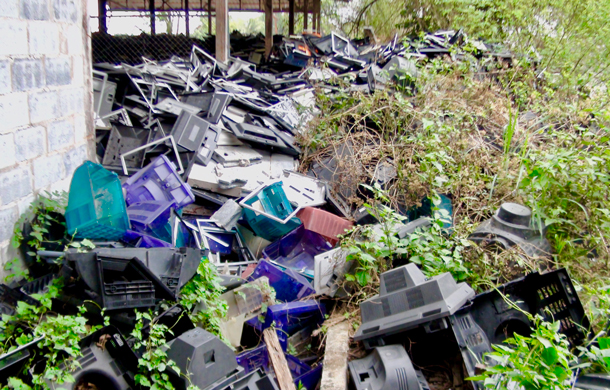
The UN recently decided to add plastic to the Basel Convention, meaning it will be classified as hazardous waste and regulated more strictly when it is moved between nations. (Photo: BaselActionNetwork, Flickr, CC BY-ND 2.0)
DYKSTRA: Well, there was a meeting in Geneva this past week; there was 180 nations that signed onto agreement as part of the UN environment program to limit plastic waste, and classify it as hazardous waste. There's only one major holdout nation, I think you might be able to guess who that is?
CURWOOD: Um, um, um -- no, not the United States!
DYKSTRA: The United States of America is sitting it out, just like we're sitting out the Paris Climate Accord.
CURWOOD: And of course, plastic comes largely from fossil fuels, in particular, natural gas.
DYKSTRA: It does. And contrast the US's disinterest with this to three particularly progressive nations from Africa that have already banned single-use plastic bags. That would be Kenya, Uganda, and Rwanda.
CURWOOD: Huh. So, Africa is literally ahead of us on this.
DYKSTRA: Africa is ahead of us on this. There are individual US cities that are moving ahead on it. And consider this one statistic. It's estimated by the year 2050, the weight of plastic in the world's oceans will be greater than the weight of fish in the world's oceans.
CURWOOD: Oh, my. Peter, let's take time to look back in history. What do you have for us today?
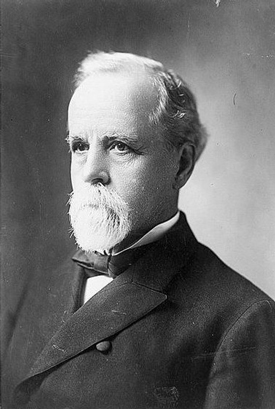
Congressman John F. Lacey (R-Iowa) authored the Lacey Act of 1900. (Photo: US Library of Congress, Wikimedia Commons, Public Domain
DYKSTRA: We'll go back to the year 1900, in late May, President William McKinley signed the Lacey Act into law. It was a big change in American conservation. One of the grandparents, if you will, of the Endangered Species Act, the Lacey Act prohibited trade in species that were considered to be vulnerable. It was prompted by the flurry of trade and the absolute slaughter of birds with some of the most beautiful plumage in the country. The Lacey Act has evolved and is still in power today. And its associated with the international effort known as CITES, the Convention on International Trade in Endangered Species.
CURWOOD: Alright, thanks, Peter. Peter Dykstra is an editor with Environmental Health News. That's EHN.org and DailyClimate.org. We'll talk to you again real soon.
DYKSTRA: All right, Steve, thanks a lot. Talk to you soon.
CURWOOD: And there's more on these stories at the Living on Earth website. That's LOE.org.
Related links:
- Reuters | “Exclusive: Presidential Hopeful Biden Looking for ‘Middle Ground’ Climate Policy”
- DW.com | “180 Countries — Except US — Agree to Plastic Waste Agreement”
- Read more about the Lacey Act of 1900
[MUSIC: Joshua Rifkin, “The Ragtime Dance” on Scott Joplin Rags, by Scott Joplin, EMI Records]
Leopard Seal Says Hello
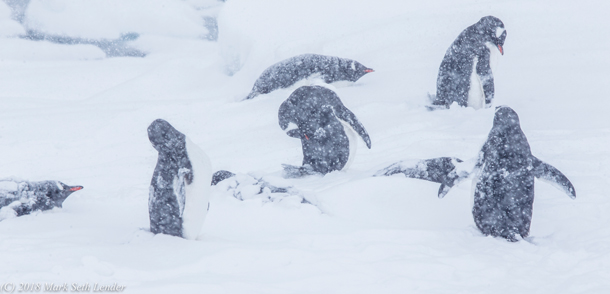
A group of chinstrap and gentoo penguins weathers a snowstorm. (Photo: Mark Seth Lender)
CURWOOD: Let’s travel now to the frigid Antarctic with Living on Earth’s Explorer in Residence Mark Seth Lender.
Leopard Seal
Half Moon Island, South Shetlands
© 2018 Mark Seth Lender
All Rights Reserved
LENDER: The ship has disappeared. The slope of the steep hill almost gone. The chinstrap penguins lie down, like stones, and let the snow drift over them. A form of shelter not available to me.
It’s time to leave.
Over the sound of the storm the penguins can still be heard. Agitated by the weather. Maybe. Or, because of something about the sea. Even before the visibility went down they would enter with hesitation and exit, leaping, onto the fast ice that bounds the shore. Leaping high. Higher than it seemed they had to though still with agility and grace.

A single chinstrap penguin waddles through the snow. (Photo: Mark Seth Lender)
By contrast I am an artless thing, encumbered by my gear, and my heavy boots and layers. I come clambering like an arthritic bear down into the Zodiac. The outboard spits, then catches, and my pilot, dead reckoning, steers towards where we figure the ship might be.
Above the clouds the sun shines, while underneath, where we are, it is all a milky dusk. The snow instead of melting when it hits the water clumps, like Greek pastries (oval and dusted white). We carve a wake through the day-for-night that disappears behind us. Not comforting. Until the pilot throttles back.

A leopard seal, one of the top predators in Antarctica. (Photo: Mark Seth Lender)
Look! he says.
And I drop to me knees, and lean out over the stern to greet to be greeted, by a monster, of the sea.
Now comes the penguins’ terror, come of his free will: The great head serpentine in form the mouth a long line the lips a blood rust red, the eyes all but black, and so deep. I see my own reflection staring back from them. And say aloud, Hello! Hello, Leopard Seal…
Leopard Seal replies only in that he does not leave. He could flip us over like tossing a rag into the air. Or with a single thrust land in our midst. Instead he listens while I talk to him replying in his silent gaze. He shows his backward curving teeth (from which there is no escape). He stays at arm’s length (which for an animal his size is very, very, close) and though he comes no closer he came to me!

A leopard seal glides through the water. (Photo: Mark Seth Lender)
Neither of us has ever seen the like of the other.
We look, and look, a shared and common recognition, that the absence of fear can be contagious.
CURWOOD: Living on Earth’s Explorer in Residence Mark Seth Lender.
Related links:
- See more on Mark Seth Lender’s website
- One Ocean Expeditions
- National Geographic | “Leopard Seal”
[MUSIC: Darol Anger/Barbara Higbie Quintet, “Egrets” on Live at Montreux, Adventure Music]
Protecting the Cook Islands from Overfishing
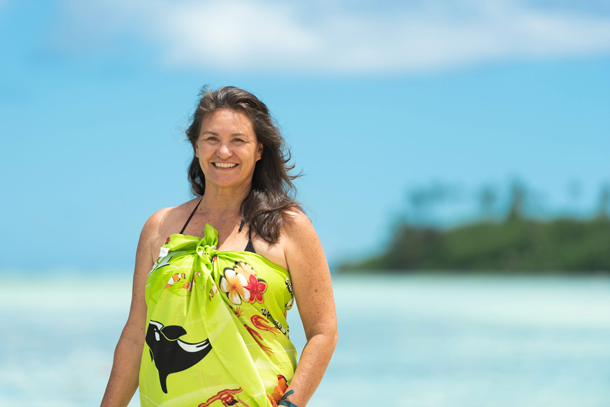
Jacqueline Evans campaigned to keep much of the Cook Islands’ waters off-limits to disruptive commercial fishing. (Photo: Goldman Environmental Prize)
CURWOOD: This year's Goldman Environmental Prize recipient for the Islands and Island Nations region of the world is Jacqueline Evans. She is a marine conservationist from the Cook Islands, a tiny island country in the South Pacific with a total land area of just 93 square miles. The rich and biodiverse ocean territory of the Cook Islands is far larger – 760,000 square miles – and until recently was at risk of overfishing. With a grassroots campaign to boost the “Sacred Ocean”, or Marae Moana Act, Ms. Evans helped create 15 Marine Protected Areas and ensured sustainable management of the entire Cook Islands ocean territory. She joins me now. Welcome to Living on Earth, and congratulations!
EVANS: Thank you very much.
CURWOOD: Please, describe the Cook Islands to someone who's never been there before.

Jacqueline Evans with her Goldman Environmental Prize Ouroboros sculpture. In addition to a monetary prize, Goldman Prize winners each receive this bronze sculpture. Common to many cultures around the world, the Ouroboros, which depicts a serpent biting its tail, is a symbol of nature’s power of renewal. (Photo: Goldman Environmental Prize)
EVANS: Well, it's a large ocean state. So 99% of our national territory is actually ocean. And we have 15 very small tropical islands, surrounded by fringing coral reefs.
CURWOOD: Now, the Cook Islands are known for rich marine biological diversity. Talk to me about the different species that live in the waters around the islands.
EVANS: We have a lot of beautiful species biodiversity there. We have about 62 threatened species, including marine turtles, species of whales, we've got the humpback whale there. And we also have some endangered fish species, the humphead wrasse, which is overfished in some parts of Southeast Asia, and lots of threatened corals.
CURWOOD: Now, how does the Sacred Ocean Act that you worked on to pass, how does this actually protect the marine life there in the Cook Islands?
EVANS: It sets up the marine protected areas around each of the 15 Islands, so they extend 50 nautical miles from the beaches of our islands. And that's where we have no large-scale commercial fishing and no seabed mining activities are allowed there. We don't have seabed mining in the Cook Islands, but we do have minerals which, you know, could potentially be exploited. So these protected areas prevent that from happening. The Marae Moana Act also enables the entire ocean territory to be protected. So any economic activities that happen outside of those 50 nautical mile zones has to be consistent with the primary objective of the Act, which is to protect the biodiversity and heritage values of our marine environment.

Jacqueline Evans on a Cook Islands shore with a local fisherman. (Photo: Goldman Environmental Prize)
CURWOOD: I understand that conservation has long been ingrained in the native Cook Islanders' Maori culture, it's called ra'ui, I believe? What is that and how is it used today.
EVANS: Yes, ra'ui is a traditional practice where the harvesting of natural resources is banned for certain periods to build up those resources in order to have at a later date. So people are used to that concept of ra'ui, and so they understand the importance of closing off areas and allowing natural resources to multiply. So that concept helped the people to understand what Marae Moana was going to be about and what it's for.
CURWOOD: So the Goldman Environmental Prize is really a wonderful honor. Why do you think you were selected? What is it that you did that won this for you — not that you did it to win a prize, but what is it that you did that caught the attention of the prize committee? And what was the key moment that you felt you had accomplished what would ultimately lead to this recognition of your work?

The six 2019 Goldman Environmental Prize recipients participated in a ceremony on Friday, April 26th. From left: Belén Curamil Canio of Chile (on behalf of her father, Goldman recipient Alberto Curamil); Jacqueline Evans of the Cook Islands; Alfred Brownell of Liberia; Linda Garcia of Vancouver, Washington; Bayarjargal Agvaantseren of Mongolia; and Ana Colovic Lesoska of North Macedonia. (Photo: Goldman Environmental Prize)
EVANS: It was probably passing that legislation. So I facilitated consultations with communities and stakeholders together — I did the consultation together with other key people in the Cook Islands. That's including the traditional leaders. And one of our champions, who's, his name is Kevin Iro. He's a rugby league celebrity in the Cook Islands, and he championed the idea of ocean conservation. So we traveled together around all of the islands to talk with the communities about this possibility of establishing legislation that would protect our ocean.
CURWOOD: Well, so now you have the Sacred Ocean Act. But how is the Cook Islands’ government going to ensure that it's enforced and that illegal fishing doesn't take place where you've outlawed it?
EVANS: Mmm, so we do have some good surveillance systems in place. And that includes satellite monitoring of vessels; any vessel that's fishing within our large ocean territory, they have to carry transponders, so our Ministry of Marine Resources can see where they're located at any time. And they can tell what activities they're doing, so they know when they're fishing and when they're not fishing. And we also have a patrol vessel, which works together with aerial surveillance. So we have various assistance from various countries, including the US and France, New Zealand and Australia, who helped us with aerial surveillance, and let us know when, you know, there are boats in the water that shouldn't be there. And so our patrol boat goes to investigate those cases.

Ms. Evans is now the director of the Marae Moana Coordination Office. (Photo: Goldman Environmental Prize)
CURWOOD: Before you go, tell me about how you felt the day or the moment that you knew, actually, this was going to work, you were going to win this struggle with the other folks who've been helping you, of course.
EVANS: I never let myself think that we've won until the legislation was actually passed through Parliament. [LAUGHS] So once it was passed through Parliament, then I let myself celebrate. And you know, say, hey, wow! We did this. [LAUGHS] So yeah, it was pretty much holding my breath up until then.
CURWOOD: Yeah, in the water, it's a useful attribute to be able to hold one's breath when swimming and everything, but that's a long time you must have been holding your breath.
EVANS: [LAUGHS] Yeah, it was about at least five years — at least over five years of holding my breath. [LAUGHS]
CURWOOD: Well, congratulations! Jacqueline Evans is a marine conservationist and she currently is the Director of the Marae Moana Coordination Office. Thank you so much for taking the time with us today. And again, congratulations for being one of the winners of the 2019 Goldman Environmental Prize.
EVANS: Thank you. Thank you very much.
Related links:
- About Jacqueline Evans, 2019 Goldman Prize Recipient – North America
- Watch: Jacqueline Evans’ Goldman story
- Listen to our conversation with 2019 North American Goldman Environmental prize recipient Linda Garcia.
[MUSIC: Ed Mann & Brian Hand, “Vibes” on Global Warming, Interworld Music]
CURWOOD: Living on Earth is produced by the World Media Foundation. Our crew includes Naomi Arenberg, Bobby Bascomb, Paloma Beltran, Thurston Briscoe, Jenni Doering, Don Lyman, Lizz Malloy, Aynsley O’Neill, Jake Rego, Joseph Winters and Jolanda Omari. Tom Tiger engineered our show. Alison Lirish Dean composed our themes. You can hear us anytime at LOE.org, iTunes and Google Play — and like us, please, on our Facebook page - PRI’s Living on Earth. We tweet from @livingonearth. And you can find us on Instagram at livingonearthradio. I’m Steve Curwood. Thanks for listening!
ANNOUNCER: Funding for Living on Earth comes from you, our listeners, and from the University of Massachusetts, Boston, in association with its School for the Environment, developing the next generation of environmental leaders. And from the Grantham Foundation for the protection of the environment, supporting strategic communications and collaboration in solving the world’s most pressing environmental problems. Support also comes from the Energy Foundation, serving the public interest by helping to build a strong, clean, energy economy.
ANNOUNCER 2: PRI, Public Radio International.
Living on Earth wants to hear from you!
Living on Earth
62 Calef Highway, Suite 212
Lee, NH 03861
Telephone: 617-287-4121
E-mail: comments@loe.org
Newsletter [Click here]
Donate to Living on Earth!
Living on Earth is an independent media program and relies entirely on contributions from listeners and institutions supporting public service. Please donate now to preserve an independent environmental voice.
NewsletterLiving on Earth offers a weekly delivery of the show's rundown to your mailbox. Sign up for our newsletter today!
 Sailors For The Sea: Be the change you want to sea.
Sailors For The Sea: Be the change you want to sea.
 The Grantham Foundation for the Protection of the Environment: Committed to protecting and improving the health of the global environment.
The Grantham Foundation for the Protection of the Environment: Committed to protecting and improving the health of the global environment.
 Contribute to Living on Earth and receive, as our gift to you, an archival print of one of Mark Seth Lender's extraordinary wildlife photographs. Follow the link to see Mark's current collection of photographs.
Contribute to Living on Earth and receive, as our gift to you, an archival print of one of Mark Seth Lender's extraordinary wildlife photographs. Follow the link to see Mark's current collection of photographs.
 Buy a signed copy of Mark Seth Lender's book Smeagull the Seagull & support Living on Earth
Buy a signed copy of Mark Seth Lender's book Smeagull the Seagull & support Living on Earth

